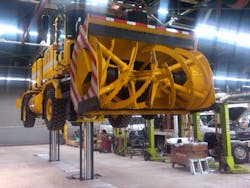According to the 2022 Old Farmer's Almanac, the North American commercial vehicle market could be in for one of the longest and most cold winters in years. Due to these wintery conditions, Stertil-Koni cautions that some vehicle maintenance facilities may not be prepared.
Inclimate weather puts much at risk for any vehicle on the road -- its safety, performance, longevity -- which impacts not only the people who service those vehicles but also many other people, who may be depending on that bus to take them to work or that truck with the week's supply of produce or that ambulance to get them to the hospital. So much depends on these vehicles being properly functioning and out on the road.
This is why Stertil-Koni is recommending vehicle maintenance shops throughout the U.S. and Canada the utilize lifts have a strategy in place. The company suggests following this 6-step approach to ensure technician safety, along with vehicle durability and performance.
Step 1: Schedule vehicle lift inspections each year
If possible, heavy duty vehicle operators should have their lifts inspected by an ALI (Automotive Lift Institute) Certified Lift Inspector. Otherwise, if one is not available in your area, have a factory or manufacturer-authorized technician service and repair your lifts.
Step 2: Increase vehicle washing intervals
During the winter, vehicles are exposed to much more than the elements. They also have to sludge through corrosive levels of road salt, dirt, and grime that cake the chassis and undercarriage. Unfortunately, a dirty vehicle can lead to added repair time and costs.
“Hazardous contaminants and road grime can adversely affect a vehicle's powertrain, potentially leading to overheating and corrosion. And, when undercarriages are not cleaned frequently, it can reduce the lifespan of engines and batteries alike,” Dr. Jean DellAmore, president of Stertil-Koni USA explains.
This means added downtime, so in response, Stertil-Koni has engineered a water-resistant heavy duty vehicle lifting system – the SKYLIFT Wash Bay model – which is a true vertical-rise platform lift with water-resistant, anti-corrosion, hot-dipped galvanized steel platforms for runways. It provides free access to the vehicle from all sides, making it easy to keep a fleet clean.
Step 3: Technician safety
Always ensure vehicles are lifted to a proper height. This means that the technician is able to comfortably move around underneath the vehicle. Also, before standing underneath the vehicle, makes sure the lift's locks are in position. Ideally, select vehicle lifting systems that have mechanical locks as standard.
Step 4: Adhere to proper lifting points
Use designated lifting points on the vehicle. For inground lifts, operators should check that the contact points are properly positioned.
Step 5: Vehicle lift stability is key
For mobile lift columns, check for a firm foundation and level ground before lifting a vehicle. Also, because these lifts can be moved outside the shop, be aware of wind loads, which are more prevalent in the winter. Further, select a lift with an “electronic synchronization” system. As the lift goes into motion and continues through the full range up to its maximum height, vehicles should rise smoothly, even those with unequal weight distribution, such as fire trucks and pumpers. Afterward, check again to be certain the lifted vehicle is level.
Step 6: Go ergonomic
Use lift accessories specifically designed to help ensure fleet maintenance operator safety and proper ergonomics. One example is a high lift wheel dolly from Stertil-Koni, which allows wheel removal and adequate alignment of dual tire assemblies and brake drums to be completed efficiently and accurately, without back strain.
“In conclusion,” notes DellAmore, “safety is always mission number one, and winter can present some real challenges. That is precisely why we suggest this six-point program, so shop technicians can perform their duties safely, efficiently, and with complete confidence. These protocols ensure higher workplace morale, greater rates of technician retention, and add longevity to the vehicles being serviced.”


